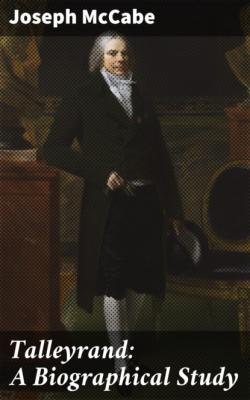ТОП просматриваемых книг сайта:
Talleyrand: A Biographical Study. Joseph McCabe
Читать онлайн.Название Talleyrand: A Biographical Study
Год выпуска 0
isbn 4064066249342
Автор произведения Joseph McCabe
Жанр Языкознание
Издательство Bookwire
Joseph McCabe
Talleyrand: A Biographical Study
Published by Good Press, 2019
EAN 4064066249342
Table of Contents
PREFACE
Sainte-Beuve, after an attempt that one cannot describe as successful, declared that “it is hardly possible to write the life of M. de Talleyrand.” Frédéric Masson noticed the figure of the great diplomatist as he passed with a disdainful “ce Sphinx.” Carlyle forgot his dogmatism for a moment, and pronounced Talleyrand “one of the strangest things ever seen or like to be seen, an enigma for future ages.” Even a woman of penetration, Mme. de Staël, who had known him well, assures us that he was “the most impenetrable and most inexplicable of men.”
There were a few who thought that the long-sealed “Memoirs” of the Prince, which were published only a few years ago, would reveal every secret. They forgot that these were the work of the man who held (improving on Voltaire) that “speech was given to man to disguise his thoughts”—the man who conducted his exit from the world with all the art he had used at the Congress of Vienna. Yet, if the “Memoirs” have thrown no light, or only a deceptive light, on some of the obscurer passages in Talleyrand’s career, they have at least filled in our picture of his personality, so that the tradition of its inscrutability must be surrendered. There has been a prolonged and microscopic research into the age or ages of Talleyrand—the Old Regime, the Revolution, the Consulate, the Restoration, and the second Revolution. The memoirs of nearly all his contemporaries have seen the light, and official records everywhere have been examined. I have made a careful use of all this research up to date, and find it possible to present a consistent and intelligible personality.
Lady Blennerhassett included the material of the “Memoirs” in the biography of Talleyrand that she wrote ten years ago. But a good deal of light has since been thrown on the earlier part of his career, and in this regard I gratefully avail myself of the investigations of M. de Lacombe. Moreover, Lady Blennerhassett is chiefly occupied with the Prince’s diplomatic action. His personality does not stand out very clearly from her very crowded canvas. That is an inherent disadvantage in writing the life of a great diplomatist. However, in spite of the alluring character of the stretch of history across which the thread of Talleyrand’s life passes, I have tried to keep it in its place as a background, and to bring out into the fullest light the elusive figure of the man who made and unmade a dozen oaths of loyalty.
J. M.
London, June, 1906.
BIBLIOGRAPHY
This Study is chiefly based on the following Works:
1. Talleyrand’s “Mémoires” (edit, de Broglie, 5 volumes); Official Correspondence from London in 1792, during the Directoire, during the Vienna Congress, and from London in 1830–4 (edit. Pallain); Letters to Napoleon, Mme. Adélaide, D’Hauterive, Choiseul-Gouffier, the Duchess of Courland, Bacourt, Royer-Collard, Guizot, and others; and his separately published Speeches and other Documents.
2. “Procès-verbal Historique des Actes du Clergé;” “Procès-verbal de l’Assemblée Nationale;” “Histoire Parlementaire” (Bouchez et Roux); and the Memoirs or Letters of Arnault, Barante, Carnot, Consalvi, von Gagern, Mme. de Genlis, Guizot, Lauzun, Las Cases, Macdonald, Meneval, Miot de Melito, Morellet, Napoleon, Pasquier, Mme. de Rémusat, Savary, Senfft, and Stapfer.
3. Of Biographies or Biographical Sketches of Talleyrand the chief are those by Lady Blennerhassett (the first authority on his diplomatic career), Brougham, Castellane, Castille, Lacombe (the best authority on his ecclesiastical career), Sir H. Bulwer Lytton (a very generous but imperfectly informed study), Mignet, Montarlot, and Place et Florens. The following writers are too imaginative or too prejudiced to be of much value: Bastide, Colmache, Marcade, Michaud, Pichot, Sainte-Beuve, Sallé, Stewartson, Touchard-Lafosse, Vars, and Villemarest.
4. Subsidiary information has been derived chiefly from “Aus dem Eheleben eines Bischofs” (anon.); Abt’s “Lebensende des F. Talleyrand;” Aulard’s “Histoire Politique de la Révolution Française;” Caro’s “La Fin du XVIII Siècle;” Crétineau-Joly’s “Bonaparte et le Concordat;” Darcy’s “L’ambassade de Talleyrand à Londres;” Demaria’s “Benevento sotto il Principe Talleyrand;” Gazier’s “Etude sur l’Histoire Réligieuse de la Révolution Française;” Goncourt’s “Histoire de la Société Française Pendant la Révolution;” Louandre’s “La Noblesse Française sous l’ancienne Monarchie;” Mongras’ “La fin d’une Société;” Michelet’s “Histoire de la Révolution;” Rambaud et Levisse’s “Histoire Générale;” Rose’s

